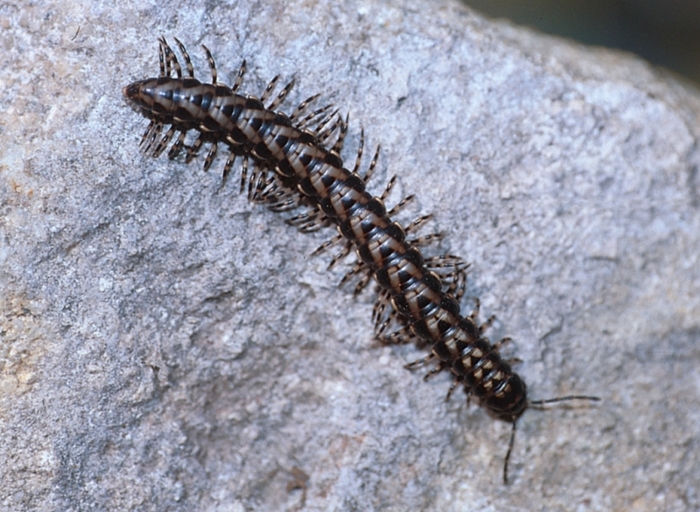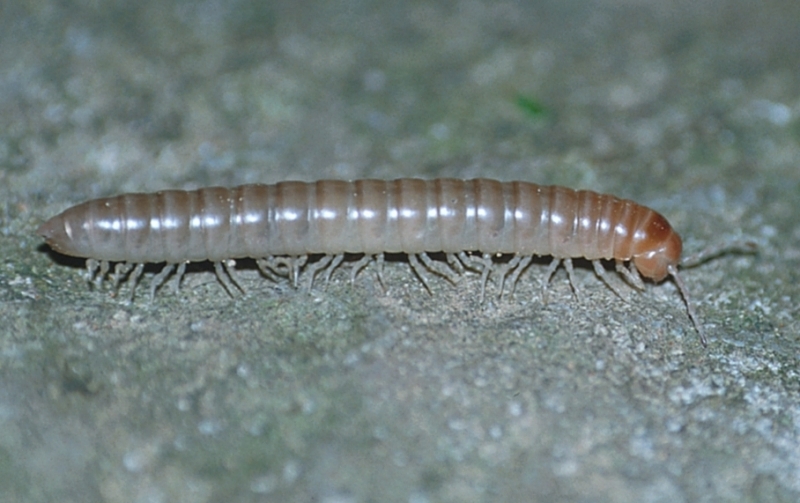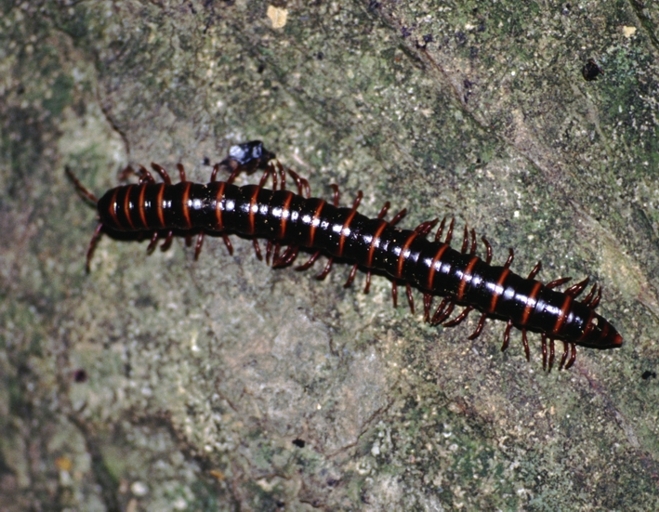Phylum Arthropoda
Subphylum Myriapoda
Class Diplopoda
Order Polydesmida
Common name: flatback millipedes, polydesmid millipedes
Overview
Polydesmidans have between 19 and 20 segments and are cylindrical but many species have wing-like lateral extensions to the tergites called paranota, giving the group its common name of 'flat-backed millipedes'. The dorsal plates and paranota are often ornamented with ridges, tubercles, and patches of colour. All polydesmidans lack eyes, and the great majority of species have either 58 or 62 legs as adults with one leg pair on each of the first three leg-bearing segments, and two leg pairs on each of the posterior 13 or 14 leg-bearing segments. The eighth leg pair in mature males is replaced by structures called gonopods, used to transfer sperm during mating. Gonopod variations are of great importance in polydesmidan taxonomy and are often the only practical basis on which to distinguish species. They have many pores along their body that produce hydrocyanide, formic acid and other irritants used for defense. Most species release the liquid slowly, but some can discharge it as a spray.
Distribution and Diversity
Polydesmida is by far the largest order of millipedes, with over 5000 species described worldwide. They are widely distributed across Australia with five families, 51 genera and 112 species, however the great majority of species remain undescribed. The only well-collected state fauna is that of Tasmania, which has 10 described and at least 120 undescribed Polydesmida. Seven introduced species of Polydesmida have been recorded in Australia.
Life cycle
Male polydesmids mate by wrapping themselves around the female and transferring a spermatophore from their gonopore to the female gonopore with the use of specially modified legs. These legs or gonopods are always on body segment 7, which is the third segment carrying two pairs of legs. Eggs are laid in cavities or chambers in the soil and guarded by the female until hatching. The juveniles possess only three pair of legs and seven body segments. Subsequent moults increases both the number of segments and legs until the adult number is reached.
Feeding
Polydesmid millipedes feed on decaying vegetation or a variety of live plants, including the leaves and shoots of ornamental plants and cultivated vegetables.
Ecology
Polydesmid millipedes are common in all environments, dwelling in leaf litter, under rocks, and under the bark of rotting logs and living trees.

Polydesmida
Image credit: Photographer: Mark Harvey
� Western Australian Museum

Polydesmida from Mount Glorious, Queensland.
Image credit: Photographer: E. S. Volschenk
� Western Australian Museum

Polydesmida from Mount Glorious, Queensland.
Image credit: Photographer: E. S. Volschenk
� Western Australian Museum

Blind cave polydesmid from Cape Range, Western Australia.
Image credit: Photographers: W. Humphreys & D. Elford
� Western Australian Museum

Polydesmida from Mount Glorious, Queensland.
Image credit: Photographer: E. S. Volschenk
� Western Australian Museum












